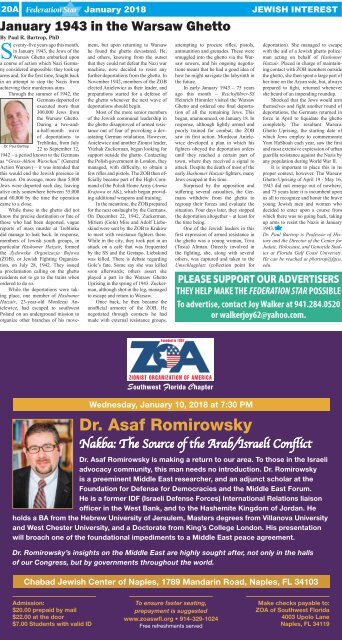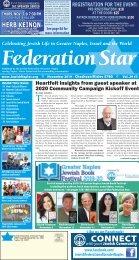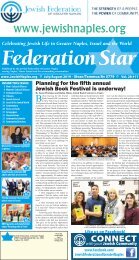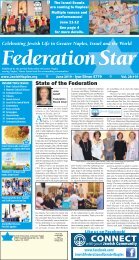Federation Star - January 2018
Create successful ePaper yourself
Turn your PDF publications into a flip-book with our unique Google optimized e-Paper software.
20A <strong>Federation</strong> <strong>Star</strong> <strong>January</strong> <strong>2018</strong><br />
<strong>January</strong> 1943 in the Warsaw Ghetto<br />
By Paul R. Bartrop, PhD<br />
Seventy-five years ago this month,<br />
in <strong>January</strong> 1943, the Jews of the<br />
Warsaw Ghetto embarked upon<br />
a course of action which Nazi Germany<br />
considered impossible: they took up<br />
arms and, for the first time, fought back<br />
in an attempt to stop the Nazis from<br />
achieving their murderous aims.<br />
Through the summer of 1942, the<br />
Germans deported or<br />
executed more than<br />
300,000 Jews from<br />
the Warsaw Ghetto.<br />
During a two-anda-half-month<br />
wave<br />
of deportations to<br />
Dr. Paul Bartrop<br />
Treblinka, from July<br />
22 to September 12,<br />
1942 – a period known to the Germans<br />
as “Gross-Aktion Warschau” (General<br />
Action Warsaw) – it was intended that<br />
this would end the Jewish presence in<br />
Warsaw. On average, more than 5,000<br />
Jews were deported each day, leaving<br />
alive only somewhere between 55,000<br />
and 60,000 by the time the operation<br />
came to a close.<br />
While those in the ghetto did not<br />
know the precise destination or fate of<br />
those who had been deported, vague<br />
reports of mass murder at Treblinka<br />
did manage to leak back. In response,<br />
members of Jewish youth groups, in<br />
particular Hashomer Hatzair, formed<br />
the Żydowska Organizacja Bojowa<br />
(ŻOB), or Jewish Fighting Organization,<br />
on July 28, 1942. They issued<br />
a proclamation calling on the ghetto<br />
residents not to go to the trains when<br />
ordered to do so.<br />
While the deportations were taking<br />
place, one member of Hashomer<br />
Hatzair, 23-year-old Mordecai Anielewicz,<br />
had escaped to southwest<br />
Poland on an underground mission to<br />
organize other branches of his movement,<br />
but upon returning to Warsaw<br />
he found the ghetto devastated. He,<br />
and others, knowing from the outset<br />
that they could not defeat the Nazi war<br />
machine, now decided to resist any<br />
further deportations from the ghetto. In<br />
November 1942, members of the ŻOB<br />
elected Anielewicz as their leader, and<br />
preparations started for a defense of<br />
the ghetto whenever the next wave of<br />
deportations should begin.<br />
Most of the more senior members<br />
of the Jewish communal leadership in<br />
the ghetto disapproved of armed resistance<br />
out of fear of provoking a devastating<br />
German retaliation. However,<br />
Anielewicz and another Zionist leader,<br />
Yitzhak Zuckerman, began looking for<br />
support outside the ghetto. Contacting<br />
the Polish government in London, they<br />
managed, with difficulty, to obtain a<br />
few rifles and pistols. The ŻOB then officially<br />
became part of the High Command<br />
of the Polish Home Army (Armia<br />
Krajowa or AK), which began providing<br />
additional weapons and training.<br />
In the meantime, the ŻOB prepared<br />
for the next onslaught by the Germans.<br />
On December 22, 1942, Zuckerman,<br />
Miriem (Gole) Mire and Adolf Liebeskind<br />
were sent by the ŻOB to Kraków<br />
to meet with resistance fighters there.<br />
While in the city, they took part in an<br />
attack on a café that was frequented<br />
by the SS and the Gestapo. Liebskind<br />
was killed. There is debate regarding<br />
Gole’s fate. Some say she was killed<br />
soon afterwards; others assert she<br />
played a part in the Warsaw Ghetto<br />
Uprising in the spring of 1943. Zuckerman,<br />
although shot in the leg, managed<br />
to escape and return to Warsaw.<br />
Once back, he then became the<br />
unofficial armorer of the ŻOB. He<br />
negotiated through contacts he had<br />
made with external resistance groups,<br />
attempting to procure rifles, pistols,<br />
ammunition and grenades. These were<br />
smuggled into the ghetto via the Warsaw<br />
sewers, and his ongoing negotiations<br />
meant that he had a good idea of<br />
how he might navigate the labyrinth in<br />
the future.<br />
In early <strong>January</strong> 1943 – 75 years<br />
ago this month – Reichsführer-SS<br />
Heinrich Himmler visited the Warsaw<br />
Ghetto and ordered one final deportation<br />
of all the remaining Jews. This<br />
began, unannounced, on <strong>January</strong> 18. In<br />
response, although lightly armed and<br />
poorly trained for combat, the ŻOB<br />
saw its first action. Mordecai Anielewicz<br />
developed a plan in which his<br />
fighters obeyed the deportation orders<br />
until they reached a certain part of<br />
town, where they received a signal to<br />
attack. Despite the death of most of the<br />
early Hashomer Hatzair fighters, many<br />
Jews escaped at this time.<br />
Surprised by the opposition and<br />
suffering several casualties, the Germans<br />
withdrew from the ghetto to<br />
regroup their forces and evaluate the<br />
situation. Four days later, they stopped<br />
the deportation altogether – at least for<br />
the time being.<br />
One of the Jewish leaders in this<br />
first expression of armed resistance in<br />
the ghetto was a young woman, Tova<br />
(Tosia) Altman. Directly involved in<br />
the fighting, she, along with several<br />
others, was captured and taken to the<br />
Umschlagplatz (collection point for<br />
JEWISH INTEREST<br />
deportation). She managed to escape<br />
with the aid of a Jewish ghetto policeman<br />
acting on behalf of Hashomer<br />
Hatzair. Placed in charge of maintaining<br />
contact with ŻOB members outside<br />
the ghetto, she then spent a large part of<br />
her time on the Aryan side, but, always<br />
prepared to fight, returned whenever<br />
she heard of an impending roundup.<br />
Shocked that the Jews would arm<br />
themselves and fight another round of<br />
deportations, the Germans returned in<br />
force in April to liquidate the ghetto<br />
completely. The resultant Warsaw<br />
Ghetto Uprising, the starting date of<br />
which Jews employ to commemorate<br />
Yom HaShoah each year, saw the first<br />
and most extensive expression of urban<br />
guerilla resistance against the Nazis by<br />
any population during World War II.<br />
It is important to place this in its<br />
proper context, however. The Warsaw<br />
Ghetto Uprising of April 19 - May 16,<br />
1943 did not emerge out of nowhere,<br />
and 75 years later it is incumbent upon<br />
us all to recognize and honor the brave<br />
2. H<br />
young Jewish men and women who<br />
E<br />
decided to enter upon a course from<br />
o<br />
which there was no going back, taking<br />
A<br />
up arms to resist the Nazis in <strong>January</strong><br />
m<br />
1943.<br />
1<br />
Dr. Paul Bartrop is Professor of History<br />
and the Director of the Center for<br />
w<br />
H<br />
Judaic, Holocaust, and Genocide Studies<br />
at Florida Gulf Coast<br />
l<br />
University.<br />
He can be reached at pbartrop@fgcu.<br />
edu.<br />
PLEASE SUPPORT OUR ADVERTISERS<br />
THEY HELP MAKE THE FEDERATION STAR POSSIBLE<br />
To advertise, contact Joy Walker at 941.284.0520<br />
or walkerjoy62@yahoo.com.<br />
Ag<br />
1. H<br />
n<br />
w<br />
(<br />
t<br />
Rab<br />
e<br />
p<br />
m<br />
w<br />
h<br />
3. A<br />
i<br />
g<br />
t<br />
4. H<br />
t<br />
Z<br />
v<br />
t<br />
h<br />
5. S<br />
Founded in 1897<br />
ZIONIST ORGANIZATION OF AMERICA<br />
Southwest Florida Chapter<br />
Wednesday, <strong>January</strong> 10, <strong>2018</strong> at 7:30 PM<br />
Dr. Asaf Romirowsky<br />
Nakba: The Source of the Arab/Israeli Conflict<br />
Dr. Asaf Romirowsky is making a return to our area. To those in the Israeli<br />
advocacy community, this man needs no introduction. Dr. Romirowsky<br />
is a preeminent Middle East researcher, and an adjunct scholar at the<br />
Foundation for Defense for Democracies and the Middle East Forum.<br />
He is a former IDF (Israeli Defense Forces) International Relations liaison<br />
officer in the West Bank, and to the Hashemite Kingdom of Jordan. He<br />
holds a BA from the Hebrew University of Jersulem, Masters degrees from Villanova University<br />
and West Chester University, and a Doctorate from King’s College London. His presentation<br />
will broach one of the foundational impediments to a Middle East peace agreement.<br />
Dr. Romirowsky’s insights on the Middle East are highly sought after, not only in the halls<br />
of our Congress, but by governments throughout the world.<br />
Chabad Jewish Center of Naples, 1789 Mandarin Road, Naples, FL 34103<br />
Admission:<br />
$20.00 prepaid by mail<br />
$22.00 at the door<br />
$7.00 Students with valid ID<br />
To ensure faster seating,<br />
prepayment is suggested<br />
www.zoaswfl.org • 914-329-1024<br />
Free refreshments served<br />
Make checks payable to:<br />
ZOA of Southwest Florida<br />
4003 Upolo Lane<br />
Naples, FL 34119


















